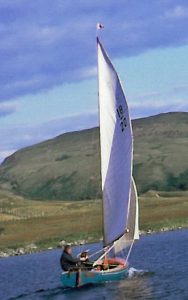 The National 18 was born in 1938 following a design competition organised by the then YRA (now the Royal Yachting Association – RYA) and Yachting World magazine.
The National 18 was born in 1938 following a design competition organised by the then YRA (now the Royal Yachting Association – RYA) and Yachting World magazine.
The original idea was for an 18 foot sailing dinghy, suitable for day sailing, yet fast enough to be of interest to racing sailors and at a reasonable cost. The plan was to produce an affordable national alternative to the many local one-designs of about this size to be found round the coast of the British Isles. The designer and boat builder Uffa Fox won the competition with his ‘Uffa Ace’ design for a clinker built wooden boat.
Rule changes in 1968, including the use of glass reinforced plastic (GRP) have maintained interest in the class: crew is usually two or three but the boat can be sailed single-handed in light winds. A number of 18s have been built in GRP to an Ian Proctor design.
The Museum’s example, Timballo, is an early boat from 1938.
Dimensions
Length 5.49m
Beam 1.83m
Draft centreboard down 1.37m


